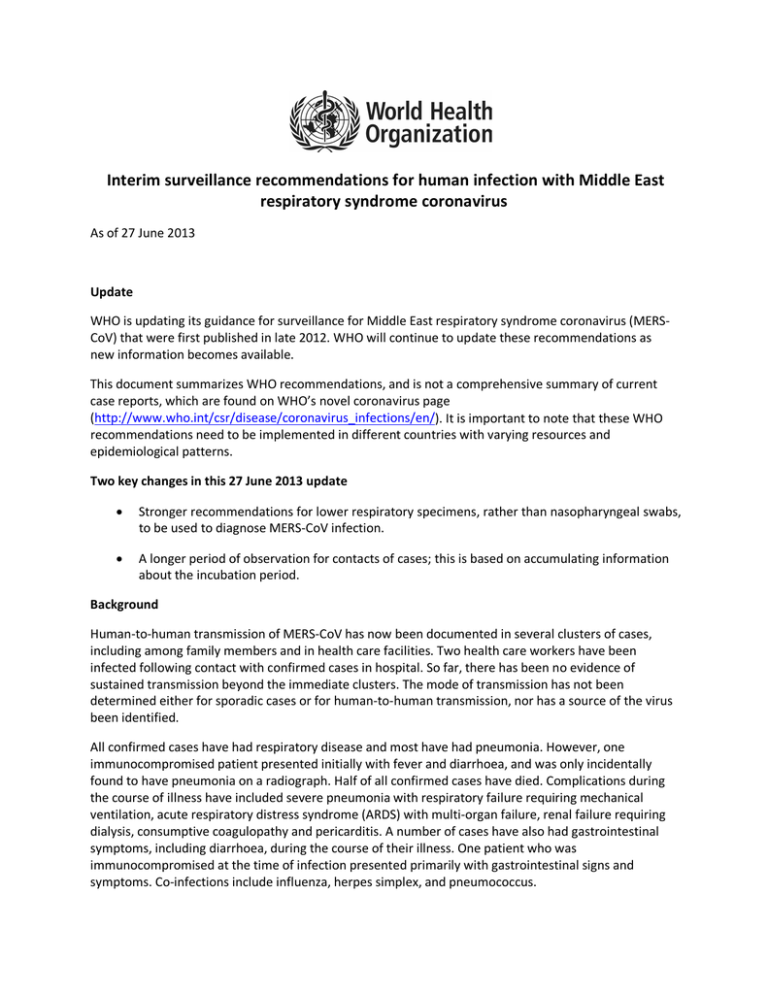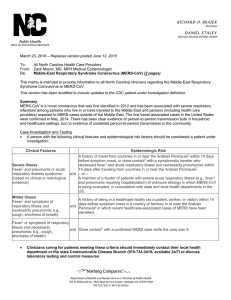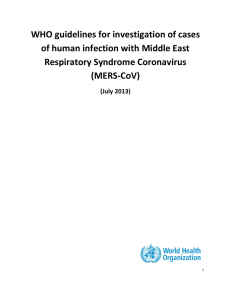Interim surveillance recommendations for human infection with Middle East
advertisement

Interim surveillance recommendations for human infection with Middle East respiratory syndrome coronavirus As of 27 June 2013 Update WHO is updating its guidance for surveillance for Middle East respiratory syndrome coronavirus (MERSCoV) that were first published in late 2012. WHO will continue to update these recommendations as new information becomes available. This document summarizes WHO recommendations, and is not a comprehensive summary of current case reports, which are found on WHO’s novel coronavirus page (http://www.who.int/csr/disease/coronavirus_infections/en/). It is important to note that these WHO recommendations need to be implemented in different countries with varying resources and epidemiological patterns. Two key changes in this 27 June 2013 update • Stronger recommendations for lower respiratory specimens, rather than nasopharyngeal swabs, to be used to diagnose MERS-CoV infection. • A longer period of observation for contacts of cases; this is based on accumulating information about the incubation period. Background Human-to-human transmission of MERS-CoV has now been documented in several clusters of cases, including among family members and in health care facilities. Two health care workers have been infected following contact with confirmed cases in hospital. So far, there has been no evidence of sustained transmission beyond the immediate clusters. The mode of transmission has not been determined either for sporadic cases or for human-to-human transmission, nor has a source of the virus been identified. All confirmed cases have had respiratory disease and most have had pneumonia. However, one immunocompromised patient presented initially with fever and diarrhoea, and was only incidentally found to have pneumonia on a radiograph. Half of all confirmed cases have died. Complications during the course of illness have included severe pneumonia with respiratory failure requiring mechanical ventilation, acute respiratory distress syndrome (ARDS) with multi-organ failure, renal failure requiring dialysis, consumptive coagulopathy and pericarditis. A number of cases have also had gastrointestinal symptoms, including diarrhoea, during the course of their illness. One patient who was immunocompromised at the time of infection presented primarily with gastrointestinal signs and symptoms. Co-infections include influenza, herpes simplex, and pneumococcus. Increasing evidence suggests that nasopharyngeal (NP) swabs are not as sensitive as lower respiratory specimens for detecting MERS-CoV infections. NP swabs have been negative in patients who were close contacts of confirmed cases and who developed pneumonia following contact. In addition, a number of cases have now had negative tests on NP swabs with positive tests of lower respiratory tract specimens. Patients in whom the diagnosis is strongly suspected on the basis of epidemiological and clinical data, may not be adequately excluded as having infection based solely on a single negative NP swab. The incubation period for cases in whom exposure is known or strongly suspected is generally less than one week. However, in at least one case, the known exposure occurred 9 to 12 days prior to onset of illness. Further evidence in cases exposed over a range of time suggest that at least in a minority of cases, incubation period may exceed one week but is less than two weeks. Recommendations for specimen collection It is strongly advised that lower respiratory specimens such as sputum, endotracheal aspirate, or bronchoalveolar lavage should be used when possible until more information is available. If patients do not have signs or symptoms of lower respiratory tract infection and lower tract specimens are not possible or clinically indicated, both nasopharyngeal and oropharyngeal specimens should be collected. The two can be combined in a single collection container and tested together. If initial testing of a nasopharyngeal swab is negative in a patient who is strongly suspected to have MERS-CoV infection, patients should be retested using a lower respiratory specimen or a repeat nasopharyngeal specimen with additional oropharyngeal specimen if lower respiratory specimens are not possible. For patients in whom adequate lower respiratory samples are not possible, investigators may also want to consider other types of auxiliary testing such as nasopharyngeal wash and paired acute and convalescent sera. Virus has also been demonstrated in other body fluids such as blood, urine, and stool but the usefulness of those body fluids in diagnosing MERS-CoV infection is uncertain. Objectives of surveillance The primary objectives of the enhancements described in this document are to: 1. Detect early, sustained human-to-human transmission. 2. Determine the geographic risk area for infection with the virus. Additional clinical and epidemiological investigations (see table below) are needed to: 1. Determine key clinical characteristics of the illness, such as incubation period, spectrum of disease, and the natural history of the disease. 2. Determine key epidemiological characteristics of the virus, such as exposures that result in infection, risk factors, secondary attack rates, and mode of transmission. The following people should be investigated and tested for MERS-CoV: 1. A person with an acute respiratory infection, which may include history of fever and cough and indications of pulmonary parenchymal disease (e.g. pneumonia or ARDS), based on clinical or radiological evidence of consolidation, who requires admission to hospital. In addition, clinicians should be alert to the possibility of atypical presentations in patients who are immunocompromised. AND any of the following: • The disease is in a cluster 1 that occurs within a 14 day period, without regard to place of residence or history of travel, unless another aetiology has been identified.3 • The disease occurs in a health care worker who has been working in an environment where patients with severe acute respiratory infections are being cared for, particularly patients requiring intensive care, without regard to place of residence or history of travel, unless another aetiology has been identified. 3 • The person has history of travel to the Middle East 2 within 14 days before onset of illness, unless another aetiology has been identified. 3 • The person develops an unusual or unexpected clinical course, especially sudden deterioration despite appropriate treatment, without regard to place of residence or history of travel, even if another aetiology has been identified, if that alternate aetiology does not fully explain the presentation or clinical course of the patient. 2. Individuals with acute respiratory illness of any degree of severity who, within 14 days before onset of illness, were in close physical contact 4 with a confirmed or probable case of MERS-CoV infection, while that patient was ill. 3. For countries in the Middle East, the minimum standard for surveillance should be testing of patients with severe respiratory disease requiring mechanical ventilation. The minimum standard should also include investigation of all those in three categories listed above—patients with unexplained pneumonia or ARDS occurring in clusters; health care workers requiring admission for respiratory disease and patients with unusual presentation or clinical course. However, countries in the Middle East are also strongly encouraged to consider adding testing for MERS-CoV to current testing algorithms as part of routine sentinel respiratory disease surveillance and diagnostic panels for pneumonia. If local capacity can support it, some testing of patients with milder, unexplained, community-acquired pneumonia requiring admission to hospital. WHO does not advise special screening at points of entry. 1 A “cluster” is defined as two or more persons with onset of symptoms within the same 14 day period, and who are associated with a specific setting, such as a classroom, workplace, household, extended family, hospital, other residential institution, military barracks or recreational camp. 2 For a map of the Middle East, see: http://www.un.org/Depts/Cartographic/map/profile/mideastr.pdf. 3 Testing should be according to local guidance for management of community-acquired pneumonia. Examples of other aetiologies include Streptococcus pneumoniae, Haemophilus influenzae type B, Legionella pneumophila, other recognized primary bacterial pneumonias, influenza, and respiratory syncytial virus. 4 Close contact is defined as: • Anyone who provided care for the patient, including a health care worker or family member, or who had other similarly close physical contact; • Anyone who stayed at the same place (e.g. lived with, visited) as a probable or confirmed case while the case was ill Reporting WHO requests that probable and confirmed cases be reported within 24 hours of classification, through the Regional Contact Point for International Health Regulations at the appropriate WHO Regional Office. See current definitions for probable and confirmed cases at: http://www.who.int/csr/disease/coronavirus_infections/case_definition/en/index.html. Investigations around cases of MERS-CoV infection Many of the critical questions regarding the clinical manifestation and epidemiological characteristics of MERS-CoV infection will be answered only by careful, detailed investigations around cases. The following provides some guidance on the types of studies that should be considered. WHO is currently working with technical partners to develop standard protocols and data collection instruments for this purpose, which will be posted when they are finalized. Please check the WHO coronavirus website for current investigation recommendations and protocols. For technical support, contact WHO on the email address outbreak@who.int with “MERS-CoV epi surv recs” in the subject line. Investigations around confirmed cases of novel coronavirus infection Investigation Complete data collection on clinical history, presentation, occurrence of complications, important laboratory and X-ray findings, and course of illness. Investigation of potential exposures in the last 14 days before onset of illness. Include travel history, exposures to animals (type of animals and type of contact), exposures to other patients with acute respiratory infections, including exposures in health care settings, and consumption of raw foods and unprocessed beverages, Collect detailed information on time, duration, and intensity of exposure and type of contact. Contact tracing, including contacts in household, workplace, school and social settings. Careful history should be taken with regard to the timing of contact with sick individuals and the onset of illness. Contacts should be tested with polymerase chain reaction (PCR) and acute and convalescent serology. Information on the severity and course of illness should be collected from even mildly symptomatic contacts who are tested for virus. Survey of health care workers working in the environment where cases are cared for. Survey should include those not directly involved in care but working in the same ward or unit as well as those who provide intermittent care, such as radiologists, respiratory and physical therapists, Purpose Describe the clinical presentation and natural history of infection. Determine the source of infection and type of exposure. Detect evidence of human-to-human transmission; estimate secondary attack rates, duration of infectivity, and incubation period. Describe spectrum of disease, especially milder cases. Detect evidence of human-to-human transmission, effectiveness of PPE. etc. Include information on timing, duration, and intensity of contact, type of interaction, use of personal protective equipment (PPE), and other potential exposures outside of health care setting (e.g. animals in the home environment). Investigations for recent increases in respiratory disease activity in the community. This would include review of local hospital admission records and outpatient records of selected general practitioners in the community where infection is thought to have been acquired. Retrospective testing of stored specimens from patients with respiratory disease. Retrospective testing of stored animal specimens for presence of MERS-CoV or antibodies. Serological surveys of potentially exposed groups of individuals such as animal workers, market workers, health care workers, and office workers (as a comparison group). Detailed information should be collected from each participant on the type and degree of exposure. Detect signals of background transmission of MERS-CoV. Detect the pre-existence of virus in the community. Determine the animal reservoir and origin of the virus. Identify types of exposure that result in infection. For questions about this document: Email outbreak@who.int. Please put “MERS-CoV epi surv recs” in the subject line.






